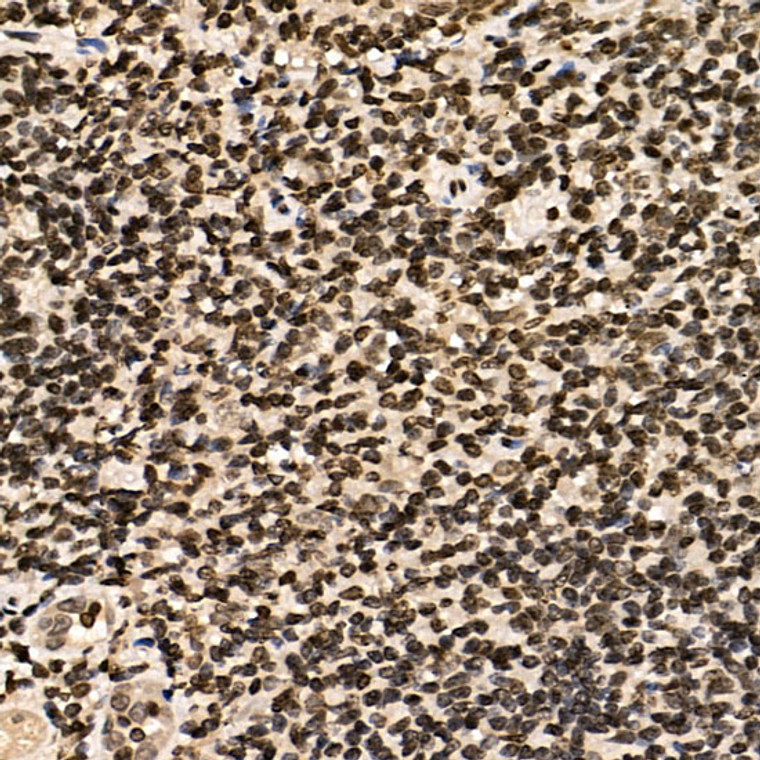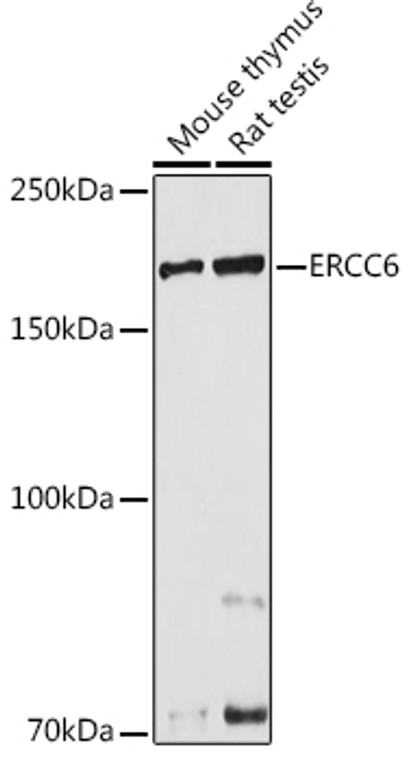| Host: |
Rabbit |
| Applications: |
WB/IHC |
| Reactivity: |
Human/Mouse/Rat |
| Note: |
STRICTLY FOR FURTHER SCIENTIFIC RESEARCH USE ONLY (RUO). MUST NOT TO BE USED IN DIAGNOSTIC OR THERAPEUTIC APPLICATIONS. |
| Short Description: |
Rabbit polyclonal antibody anti-ERCC6 (700-800) is suitable for use in Western Blot and Immunohistochemistry research applications. |
| Clonality: |
Polyclonal |
| Conjugation: |
Unconjugated |
| Isotype: |
IgG |
| Formulation: |
PBS with 0.05% Proclin300, 50% Glycerol, pH7.3. |
| Purification: |
Affinity purification |
| Dilution Range: |
WB 1:500-1:1000IHC-P 1:50-1:200 |
| Storage Instruction: |
Store at-20°C for up to 1 year from the date of receipt, and avoid repeat freeze-thaw cycles. |
| Gene Symbol: |
ERCC6 |
| Gene ID: |
2074 |
| Uniprot ID: |
ERCC6_HUMAN |
| Immunogen Region: |
700-800 |
| Immunogen: |
A synthetic peptide corresponding to a sequence within amino acids 700-800 of human ERCC6 (NP_000115.1). |
| Immunogen Sequence: |
LPVFMEQFSVPITMGGYSNA SPVQVKTAYKCACVLRDTIN PYLLRRMKSDVKMSLSLPDK NEQVLFCRLTDEQHKVYQNF VDSKEVYRILNGEMQIFSGL I |
| Post Translational Modifications | Phosphorylated in a cell cycle-dependent manner at Ser-158 by cyclin A-CDK2 and at Ser-10 by ATM in response to DNA damage. Phosphorylation at these two sites promotes the intramolecular interaction of the N-terminal domain with the helicase ATP-binding domain, thereby probably releasing the inhibitory effect of the N-terminal domain on its ATPase activity. Phosphorylation is essential for its chromatin remodeling activity. Ubiquitinated at the C-terminus. Ubiquitination by the CSA complex leads to ERCC6 proteasomal degradation in a UV-dependent manner. Stabilized following interaction with KIAA1530/UVSSA, which promotes recruitment of deubiquitinating enzyme USP7, leading to deubiquitination of ERCC6 thereby preventing UV-induced degradation of ERCC6 by the proteasome. Sumoylation at Lys-205 in an UV-radiation-dependent manner is essential for its transcription-coupled nucleotide excision repair activity. |
| Function | Essential factor involved in transcription-coupled nucleotide excision repair which allows RNA polymerase II-blocking lesions to be rapidly removed from the transcribed strand of active genes. Upon DNA-binding, it locally modifies DNA conformation by wrapping the DNA around itself, thereby modifying the interface between stalled RNA polymerase II and DNA. It is required for transcription-coupled repair complex formation. It recruits the CSA complex (DCX(ERCC8) complex), nucleotide excision repair proteins and EP300 to the sites of RNA polymerase II-blocking lesions. Plays an important role in regulating the choice of the DNA double-strand breaks (DSBs) repair pathway and G2/M checkpoint activation.DNA-dependent ATPase activity is essential for this function. Regulates the DNA repair pathway choice by inhibiting non-homologous end joining (NHEJ), thereby promoting the homologous recombination (HR)-mediated repair of DSBs during the S/G2 phases of the cell cycle. Mediates the activation of the ATM- and CHEK2-dependent DNA damage responses thus preventing premature entry of cells into mitosis following the induction of DNA DSBs. Acts as a chromatin remodeler at DSBs.DNA-dependent ATPase-dependent activity is essential for this function. Remodels chromatin by evicting histones from chromatin flanking DSBs, limiting RIF1 accumulation at DSBs thereby promoting BRCA1-mediated HR. Required for stable recruitment of ELOA and CUL5 to DNA damage sites. Involved in UV-induced translocation of ERCC8 to the nuclear matrix. Essential for neuronal differentiation and neuritogenesis.regulates transcription and chromatin remodeling activities required during neurogenesis. |
| Protein Name | Dna Excision Repair Protein Ercc-6Atp-Dependent Helicase Ercc6Cockayne Syndrome Protein Csb |
| Database Links | Reactome: R-HSA-427389Reactome: R-HSA-5250924Reactome: R-HSA-6781823Reactome: R-HSA-6781827Reactome: R-HSA-6782135Reactome: R-HSA-6782210Reactome: R-HSA-73762 |
| Cellular Localisation | Nucleus |
| Alternative Antibody Names | Anti-Dna Excision Repair Protein Ercc-6 antibodyAnti-Atp-Dependent Helicase Ercc6 antibodyAnti-Cockayne Syndrome Protein Csb antibodyAnti-ERCC6 antibodyAnti-CSB antibody |
Information sourced from Uniprot.org
12 months for antibodies. 6 months for ELISA Kits. Please see website T&Cs for further guidance










